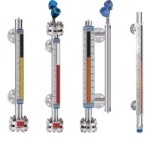Fluid process control operations frequently involve the storage of liquids in a vessel or tank. The continuous and accurate indication of the liquid level within the tank is an important data point for process control decision making and safety. Several tank level measurement methods and instrument types are available, each with its own set of characteristics that may be advantageous for a specific installation.
A tank liquid level indicator's selection criteria often include:
- Does the process require direct or indirect measurement of level?
- What level measurement accuracy and reliability is needed?
- What is the tank shape, regular or irregular?
- Are there concerns with media compatibility with measurement device materials of construction?
- How often will maintenance or calibration be needed?
- Is the instrument capable of operating at the process temperature and pressure for the application?
- Does the application require local display and visibility or remote?
- Are control signals from the level indication required? What type and transmission protocol?
- What kind of redundancy and safety devices, such as additional switches, are needed?
Magnetically coupled liquid level indicators, or MLIs, are widely used in the process industry. They are accurate, consistent, and reliably indicate liquid level. These units are completely sealed and do not require any maintenance. MLIs also eliminate the vapor or liquid emission issues that plague sight and gauge glasses.
Most Compelling Reasons for Using MLI's:
- Level measurement is continuous.
- Operable without the use of electricity.
- Regardless of tank shape or profile, they provide a direct visual tank fluid level indication.
- They are available in wide operating temperature and pressure ranges.
- MLI construction is resistant to breakage.
- A variety of materials are available to accommodate corrosive media.
- Externally mounted measuring indicators, switches, and transmitters do not come into contact with the process media.
- MLI's provide a continual operation that requires little maintenance.
- The level indication is viewable from a greater distance than glass sight gauges.
- With a single instrument, it is possible to measure large fluid level ranges.
Magnetic level indicators have a strong presence in tank liquid level measurement and should be considered a candidate for meeting those application requirements. There are numerous options for customizing the level indicator for each application. Work with your local Sales Engineer, a specialist in level measurement, about your application challenges and positive outcomes.
For more information, contact your local Miller Energy, Inc. regional office:
South Plainfield, NJ Office
Serving Northern NJ, New York, and Fairfield County Connecticut
South Clinton Ave.
South Plainfield, NJ 07080
Phone: 908-755-6700
Toll Free: 800-631-5454
Fax: 908-755-0312
Exton, PA Office
Serving Southern NJ, Eastern PA, Delaware and Central and Eastern Maryland
505 Gordon Drive
Exton, PA 19341
Phone: 610-363-6200
Toll Free: 888-631-5454
Fax: 610-524-7254
Cleveland, OH Office
Serving Ohio
555 Golden Oak Parkway
Cleveland, OH 44146
Phone: 440-735-0100
Fax: 440-735-0123








